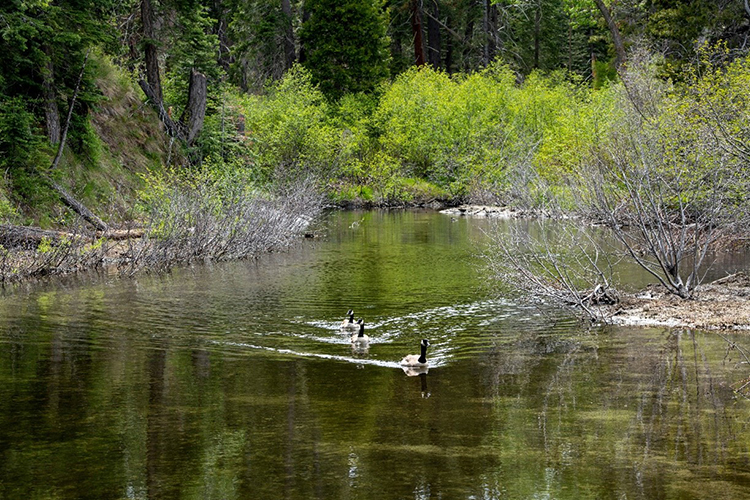California State Parks Returns the Washoe Name dukMéʔem wáta to Features and Facilities at Ed Z’Berg Sugar Pine Point State Park
Contacts:
Kaytlen Jackson
Public Information Officer
California State Parks Sierra District
(530) 489-8909
Herman Fillmore
Culture/Language Resources Director
Washoe Tribe of NV and CA
(775) 782-0013 ext. 52202
 dukMéʔem wáta. Photo from California State Parks
dukMéʔem wáta. Photo from California State Parks
TAHOMA – California State Parks is returning the names of features and facilities within Ed Z’berg Sugar Pine Point State Park to their traditional Washoe name, dukMéʔem wáta (dook-MEH-em wah-tah), which means “Wave Creek” beginning this summer.
In early 2024, State Parks received a request from the Washoe Tribe of Nevada and California to return the traditional Washoe name dukMéʔem wáta to the creek that runs through Ed Z’ Berg Sugar Pine Point State Park and to change the names of features and facilities within the park that are attributed to the historic figure General Phipps: General Creek Campground and General Creek Loop Trail. In response, State Parks Director Armando Quintero signed a Director’s Action Request in October 2024, officially changing the names of the facilities to dukMéʔem wáta Campground and dukMéʔem wáta Loop Trail.
“The return of the traditional Washoe name to this creek honors the history and presence of the Washoe people in the Lake Tahoe Basin,” said State Parks Director Armando Quintero. “This connection reinforces the cultural insight carried through generations and allows State Parks, as co-stewards of these lands, to interpret and share Washoe lifeways with greater respect. It exemplifies the goals of the Reexamining Our Past Initiative—creating a more inclusive and accurate understanding of place.”
Washoe elders, who were consulted with on the name return, discussed how this area has experienced large waves. A story shared by Elders with Tribal Chairman Serrell Smokey, is “a Wá·šiw man with wegeléyu (special powers) had a vision of a tidal wave generating from the north shore of Tahoe going across the lake to the south. In his vision, there is a large boulder on a ledge under the water a few hundred feet and there will be an earthquake that will make it fall and cause this to happen.” Archaeological evidence and traditional ecological knowledge held by the tribe suggest that the traditional name commemorates a historical seiche (lake tsunami) wave event that may correlate with the McKinney Bay Landslide that occurred 12,000 to 20,000 years ago.
The memorializing of dukMéʔem wáta also recognizes Wá·šiw presence in the Lake Tahoe Basin since time immemorial. The name, dukMéʔem wáta, is one of many captured in Wá·šiw legends that have been passed down within the Washoe Tribe over thousands of years. While Wá·šiw legends often teach morals and cultural teachings, they also depict firsthand accounts of events occurring within their homelands since the beginning of time. The Washoe Tribe has maintained this knowledge despite attempts to eradicate their language, culture and peoples.
Reexamining Our Past Initiative
This name change is a part of the Reexamining Our Past Initiative, wherein State Parks is critically looking at contested placenames, identifying and removing residual derogatory placenames, and inappropriate honorifics in California’s State Parks System.
The return of the name will allow State Parks to interpret Washoe lifeways with greater accuracy and to describe traditional place names and their relevancy to the Washoe people and all park visitors today. This returning of the Washoe name to this creek and the associated park facilities is consistent with the Governor’s Truth and Healing Council and the Reexamining Our Past Initiative as well as the Memorandum of Understanding (MOU) between the Washoe Tribe and State Parks signed in 2023.
The return of dukMéʔem wáta as the official place name for the area not only recognizes the history of the Washoe Tribe through the return of the Wá·šiw language to place but builds upon previously establish MOU’s between California State Parks and tribes throughout California that seek the return of Indigenous Peoples and Practices to Land. While today place names recognize modern history, for many Indigenous Peoples those places are remembered much differently and have names and stories that honor these places and their histories since the beginning.
Background and History
Previously, these features and facilities were attributed to “General” William Phipps, who arrived in the Lake Tahoe Basin in the 1850s and received a land grant on July 1, 1869, that included a portion of the park. Little is known of Phipps’ life prior to his arrival in California during the Gold Rush, however, archival research indicates he was not a United States General and there is no record of his military service. A history of the Tahoe area published in 1957 describes Phipps murdering a man called “One-Eyed John” (likely a Washoe ancestor), stealing his beaded footwear and leaving his body to be eaten by wolves. Tribal oral history confirms that Washoe people stayed away from Phipps’ land during his lifetime, even though they visited and worked for his immediate neighbors to the north and south.
The proposal to restore the name dukMéʔem wáta on official United States maps has been referred by the U.S. Board of Geographic Names (BGN) to the California Advisory Committee on Geographic Names (CACGN). At an upcoming meeting, CACGN will recommend action on the proposal, and BGN will schedule a final vote once they have received CACGN's recommendation.
Subscribe to California State Parks News via e-mail at NewsRoom@parks.ca.gov
California State Parks provides for the health, inspiration and education of the people of California by helping to preserve the state’s extraordinary biological diversity, protecting its most valued natural and cultural resources, and creating opportunities for high quality outdoor recreation.
